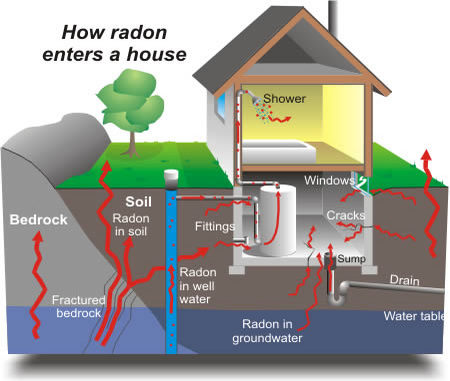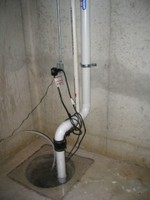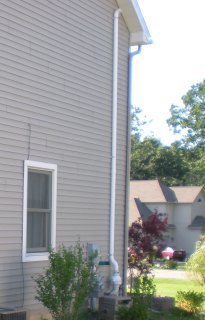Inside Washtenaw County Public Health: Helping you fight the invisible invader, radon

Angela Parsons, Washtenaw County Public Health
I received a call a while back from a homeowner who had tested her home for radon using one of the do-it-yourself test kits we sell at our office. She conducted the test in her basement, and the results came back at 177.2 picocuries per liter of air (pCi/L).
To put this level into perspective, the EPA recommends that people take action to reduce their radon level if it is above 4.0 pCi/L. The average outdoor level of radon is between 0.3 pCi/L and 0.7 pCi/L, and the average indoor radon level is 1.3 pCi/L. In my nearly 10 years on the job, this was by far the highest radon level I had ever witnessed from our test kits.
Unfortunately, this homeowner is not alone in Washtenaw County — more than 40 percent of Washtenaw County homes are estimated to have radon levels above 4.0 pCi/L.
What exactly is radon? Radon is a naturally occurring, radioactive gas formed by the breakdown of uranium. It is tasteless, colorless and odorless and is found in many types of soil and rocks. It can enter homes through cracks in foundations, sump pump crocks, crawl spaces, or other openings. Radon is present in outdoor air, but is diluted to such low levels that it’s usually not a concern. However, inside an enclosed space (like a home), radon can build up to dangerous levels. Any home can have a radon problem — new and old homes, well-sealed and drafty homes and homes with or without basements.

How radon enters a home.
Radon is classified by the (EPA) as a Class A carcinogen — that is, one that is known to cause cancer in humans. Other Class A carcinogens include tobacco smoke, asbestos and benzene. The concern with radon is that it can contribute to your risk of lung cancer. When radon gas is inhaled, it decays into radioactive particles that become trapped in your lungs. These radioactive particles can cause damage to lung tissue, and, over time, this tissue damage can result in lung cancer. In fact, radon is the second leading cause of lung cancer in the United States, resulting in approximately 21,000 lung cancer deaths each year.
Radon doesn’t cause other symptoms like headaches, asthma or allergies. Not everyone who breathes radon will develop lung cancer. Your chance of getting lung cancer from exposure to radon depends mostly on the following:
- How much radon is in your home
- How much time you spend in your home
- Whether you currently smoke or have smoked in the past
Fortunately for the homeowner, and for others like her who find elevated levels of radon, fixing a radon problem is relatively easy and inexpensive (in the grand scheme of home repairs, that is!). Having a company install a radon mitigation system typically costs between $800 - $1,000.

Radon vent pipe in sump pump pit.
The best method of reducing radon levels involves installing a vent pipe through your home to vent the radon to the outside. This procedure is referred to as "subslab depressurization." Typically, a hole is drilled through the basement floor (or a sump pit is used), and a PVC pipe is placed in the hole and routed to the outside. A fan is then attached to the pipe to create suction to draw the radon into the pipe, rather than allowing it to creep into the home. A gauge is placed on the pipe to indicate that it is creating suction.
A similar technique is used in homes with a crawl space. In addition to the vent pipe, a layer of plastic is placed on the floor of the crawl space and sealed around the edges to create a vapor barrier.

Radon vent pipe on outside of home.
Another question I often get is regarding radon testing and mitigation requirements and laws. Unfortunately, there are not very many regulations on the books when it comes to radon. Here is a rundown of radon-related requirements:
State of Michigan:
- Must list test results (if known) on Seller's Disclosure Statement when selling a home.
- The lowest level of the all Licensed Family and Group Child Care Homes must have levels of radon less than 4.0 pCi/L. Documentation of the results must be kept on file in the home.
Washtenaw County:
- Radon-resistant construction techniques must be used for new homes being built and for major additions to existing homes (installing the PVC vent pipe during construction, among other things).
City of Ann Arbor:
- In rental units, no part of a cellar may be used as habitable space unless a radon test, conducted by an independent accredited contractor, indicates acceptable levels of radon.
So, what do I tell people when they ask me about radon?
- Test your home for radon! We always have test kits available at our Environmental Health office, located at 705 N. Zeeb Road on the west side of Ann Arbor. They're usually $10, but they're only $5 during the month of January in recognition of Radon Action Month.
- Fix your home if the radon level is above 4.0 pCi/L.
- Stop smoking! This contributes to your lung cancer risk substantially more than radon does.
By the way, the homeowner who tested at 177.2 pCi/L called a local mitigation company and had a radon system installed on her home. Her radon level is now around 2 pCi/L, and her family’s risk of developing lung cancer has been dramatically reduced.
For more information, check out our radon web page.
Angela Parsons is an Environmental Health Education Coordinator with the Washtenaw County Environmental Health Division of the Public Health Department. She can be reached at parsonsa@ewashtenaw.org or 734-222-3869.

